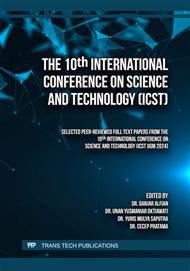[1]
Adri, Wahyudi., L.M. Sabri, d & Yasser Wahyuddin. Pembuatan Peta Jalur Evakuasi Bencana Gunung Api dan Persebaran Lokasi Shelter Menggunakan Metode Network Analyst (Studi Kasus: Gunung Merapi, Boyolali Magelang). Jurnal Geodesi Undip, 10 (1), 189-196, (2021).
DOI: 10.24815/jpg.v7i2.28458
Google Scholar
[2]
Auditia, F., & Nugroho, H. Evaluation of ASTER, SRTM, and DEMNAS DEM Data for Lahar Modelling: A Case Study of Lahar from Mount Galunggung, Indonesia. Prosiding FTSP Series, 464-466, (2021)
Google Scholar
[3]
Arisandy, A. S. & Sukojo, B. M. Studi Penentuan Aliran Hidrologi Metode Steepest Slope dan Metode Lowest Heights dengan Aster GDEMV2 dan Alos Palsar (Studi Kasus: Gunung Kelud, Jawa Timur). Jurnal Teknik ITS, 15 (2), A837-A841, (2016).
DOI: 10.12962/j23373539.v5i2.17242
Google Scholar
[4]
Armijon, Setyanto, Angin, G. P., Rahmadi, E., & Purba, A. Pemodelan Analisis Spasial Aliran Lahar Dingin untuk Mitigasi Bencana Gunung Merapi. (Laporan Penelitian, Fakultas Teknik Sipil, Universitas Lampung: Lampung). (2018), Available online: http://repository.lppm.unila.ac.id/13969/ (accessed on 29 May 2024).
Google Scholar
[5]
De Bélizal, E., Lavigne, F., Hadmoko, D. S., Degeai, J. P., Dipayana, G. A., Mutaqin, B. W., Marfai, M. A., Coquet, M., Mauff, B. Le, Robin, A. K., Vidal, C., Cholik, N., & Aisyah, N. Rain-triggered lahars following the 2010 eruption of Merapi volcano, Indonesia: A major risk. Journal of Volcanology and Geothermal Research, 261, 330-347, (2013).
DOI: 10.1016/j.jvolgeores.2013.01.010
Google Scholar
[6]
Dille, A., Poppe, S., Mossoux, S., Soulé, H., & Kervyn, M. Modeling Lahars on a Poorly Eroded Basaltic Shield: Karthala Volcano, Grande Comore Island. Frontiers in Earth Science, 8, 369. (2020).
DOI: 10.3389/feart.2020.00369
Google Scholar
[7]
Indarto, Indarto., Wahyuningsih, S., Usman, F., & Rohman, L. Pembuatan Jaringan Sungai Dan Karakteristik Topografi DAS dari DEM- JATIM. Media Teknik Sipil, 8 (2), 99-108, (2008).
Google Scholar
[8]
Kurniawan, V. O., Mei, E. T. W. & Hadmoko, D. S. Pemodelan Aliran Lahar Gunung Api Merapi untuk Perhitungan Risiko Kerugian pada Penggunaan Lahan Terdampak di Bantaran Sungai Boyong, Pakem, Sleman, D.I. Yogyakarta. Journal of Geography of Tropical Environments, 3 (2), 22-44, (2019).
DOI: 10.7454/jglitrop.v3i2.64
Google Scholar
[9]
Pemerintah Kabupaten Sleman. Dokumen Kontijensi Gunung Api Merapi, 2012.
Google Scholar
[10]
Pitang, Yuliani., Ode Irman, & Yosefina Nelista. The Effect of Training on Preparedness Disaster on The Preparedness of Elementary School Children in Overcoming the Disaster of Volcano Eruption of Mount Egon in Lere Catholic Elementary School. NurseLine Journal. 4 (2), 139-145, (2019).
DOI: 10.19184/nlj.v4i2.14356
Google Scholar
[11]
Rachmawati, L. Pengetahuan Penduduk Terhadap Peta Kawasan Rawan Bencana dan Mitigasi Bencana Merapi. Jurnal Kependudukan Indonesia, 13 (2), 143-156, (2018).
DOI: 10.21831/gm.v14i1.13778
Google Scholar
[12]
Sawungrana, A. R., & Purwanto, T. H. Pemanfaatan Data ASTER GDEM dan SRTM untuk Pemodelan Aliran Lahar Gunung Kelud Pasca Erupsi 2014. Jurnal Bumi Indonesia, 6 (1). 1-9, (2017).
Google Scholar
[13]
Schilling, S. P. LAHARZ: GIS programs for automated mapping of lahar inundation hazard zones. U. S. Geological Survey, Washington, 1998.
DOI: 10.3133/ofr98638
Google Scholar
[14]
Wibowo, S. B., Lavigne, F., Mourot, P., Métaxian, J., Zeghdoudi, M., Virmoux, C., Sukatja, C. B., Hadmoko, D. S., Mutaqin, B. W. Analyse couplée d'images vidéo et de données sismiques pour l'étude de la dynamique d'écoulement des lahars sur le volcan Merapi, Indonésie. Géomorphologie: relief, processus, environnement, 21 (3), 251 – 266, (2015).
DOI: 10.4000/geomorphologie.11090
Google Scholar


